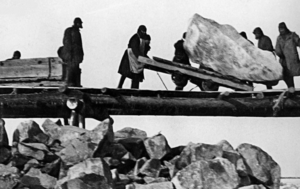Gulag facts for kids
The Gulag was a huge system of prison camps run by the Soviet Union. These camps existed from the 1930s to the 1950s. After the Soviet Union started in 1917, it put people in prison who disagreed with the government. This was similar to older Russian prison camps called katorga. But the Soviet Union's prison system grew to be one of the largest ever.
Contents
Why the Gulag System Started
During the 1920s, the Soviet Union put more and more people in prison. These were people who didn't agree with the government. Leaders thought it was a good idea to make these prisoners work. Their work and the things they made would help the country's economy. In fact, about 2 out of every 100 workers in the Soviet Union were Gulag prisoners.
The Gulag system officially started in 1930. During the 1930s, people were very afraid of the Soviet government. Police were told to arrest and imprison many people. This happened even for small reasons or if they were innocent. This made the Gulag system grow much bigger. By 1936, there were 5 million prisoners in the Gulags.
Where Gulag Camps Were Located
Many people think the Gulag camps were only in Siberia. However, these prison camps were actually located all over the Soviet Union. Siberian camps made it harder for prisoners to run away. But it was also harder to get food and supplies to these camps. Moving goods in and out was difficult because the camps were so far away.
The End of the Gulag System
The Gulag system began to end in the 1950s. This happened after the death of Joseph Stalin. Many prisoners were released starting in 1954. The Gulag program officially ended with a government order in 1960.
The Gulag administration reported that 10 million people were sent to the Gulags between 1934 and 1947. However, experts from other countries believe the numbers are much higher. They estimate that between 1918 and 1956, 15 million to 30 million people died in the Gulags.
Images for kids
-
Genrikh Yagoda (middle) inspecting the construction of the Moscow-Volga canal. Behind his right shoulder is a young Nikita Khrushchev.
-
Group of prisoners in Sakhalin, remote prison island, c. 1903
-
Central shop in Norilsk built by prisoners of the Norillag
-
Lithuanian deportees preparing logs for rafting on the Mana River
-
Part of 'Project 503' to build a railroad from Salekhard to Igarka near Turukhansk on the Yenisey
-
OGPU chiefs responsible for construction of the White Sea–Baltic Canal: right: Frenkel; center: Berman; left: Afanasev (Head of the southern part of BelBaltLag)
-
Memorial in St. Petersburg
-
Gulag Museum in Moscow, founded in 2001 by historian Anton Antonov-Ovseyenko
See also
 In Spanish: Gulag para niños
In Spanish: Gulag para niños






















